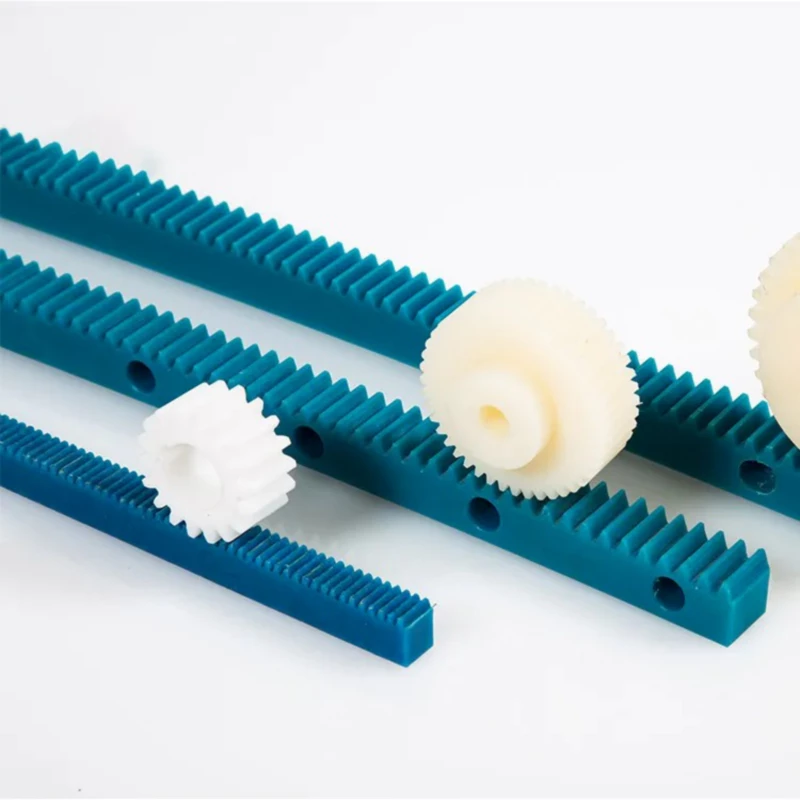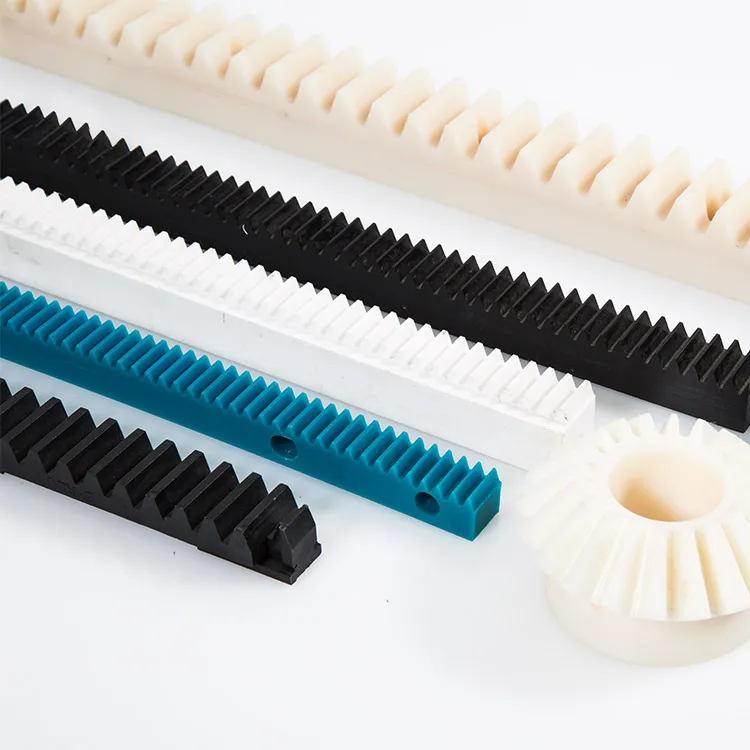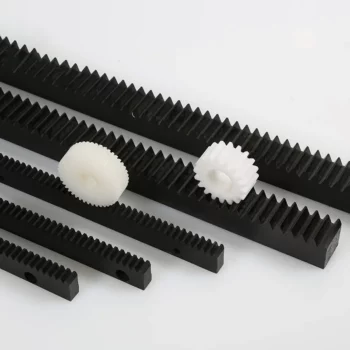Can Plastic Gear Racks Be Used in Agricultural Irrigation Systems?
Plastic Gear Rack is a type of rack made from plastic, used to transmit power and motion. It consists of a series of teeth and gaps that mesh with a gear to convert rotational motion into linear motion. This blog will explore the structure, materials, advantages, applications, installation, maintenance, and selection of plastic gear racks, particularly in the context of agricultural irrigation systems.
Structure and Materials
A. Composition of Plastic Rack
The basic structure of a Plastic Gear Rack consists of a series of teeth and gaps. These teeth are designed to mesh with a gear, enabling the transfer of force and motion. The design of the rack and the profile of the teeth play a crucial role in the efficiency and effectiveness of power transmission.
B. Commonly Used Plastic Materials
Common plastic materials used for gear racks include polyamide (PA), polyethylene (PE), and polypropylene (PP). These materials are chosen for their strength, durability, and resistance to wear and tear.

Advantages
1. Lightweight and Corrosion Resistance
Plastic gear racks are significantly lighter than their metal counterparts, which makes them easier to handle and install. Additionally, they are resistant to corrosion, making them ideal for use in environments where moisture or chemicals are present.
2. Low Noise and Low Friction
Plastic gear racks operate quietly due to their material properties, reducing noise pollution. Their low friction also contributes to smoother operation and less wear on components.
3. Cost-Effective and Easy to Process
Manufacturing plastic gear racks is generally more cost-effective compared to metal ones. They are easier to process, allowing for more complex designs and customizations.
4. Design Flexibility
The versatility of plastic allows for a wide range of design possibilities, giving engineers the flexibility to create gear racks that meet specific requirements and applications.
5. Resistance to Chemicals and Moisture
Plastic gear racks are highly resistant to chemicals and moisture, making them suitable for use in harsh environments where metal racks might degrade quickly.
6. Reduced Wear on Other Components
Due to their softer nature, plastic gear racks cause less wear on mating components, thereby extending the lifespan of the entire system.

Applications
Automation and Robotics
Plastic Gear Rack is widely used in automation and robotics systems for precise motion control and power transmission. It is utilized in robotic arms, gantry systems, linear actuators, and other automated machinery.
Electric Tools and Appliances
Plastic Gear Rack is employed in electric tools such as drills, saws, and sanders, where it helps convert rotational motion into linear motion. It is also used in household appliances like mixers, blenders, and printers for smooth and efficient operation.
Transportation and Automotive
Plastic Gear Rack is utilized in various transportation and automotive applications. It can be found in steering systems, seat adjustment mechanisms, window regulators, and convertible tops, providing reliable and precise movement.
Medical Equipment
Plastic Gear Rack is used in medical equipment such as hospital beds, patient lifts, and adjustable tables. Its lightweight, corrosion-resistant, and low-noise properties make it suitable for healthcare settings.
Packaging and Material Handling
Plastic Gear Rack is employed in packaging and material handling machinery to facilitate the movement of products along conveyor systems or for precise positioning in packaging operations.
Industrial Machinery
Plastic Gear Rack is utilized in various industrial machinery, including CNC machines, cutting systems, textile machinery, and printing presses. Its low friction and wear properties contribute to smooth operation and reduced maintenance.
Agricultural Equipment
Plastic Gear Rack finds applications in agricultural machinery, such as crop harvesters, seeders, and irrigation systems. It helps in the efficient movement of components and ensures precise control in agricultural operations.
Recreation and Sports Equipment
Plastic Gear Rack is used in recreational and sports equipment, such as exercise machines, bicycles, and golf carts, to convert rotational motion into linear motion for enhanced performance.
Renewable Energy Systems
Plastic Gear Rack is employed in renewable energy systems, including solar panel tracking systems and wind turbine pitch control mechanisms, to optimize energy generation and tracking capabilities.


Installation and Maintenance
Installation
1. Choose the Appropriate Installation Location
Select a location that ensures the gear rack is properly aligned with the mating gear and other system components. The location should also facilitate easy access for maintenance.
2. Align and Secure
Properly align the gear rack with the mating gear to ensure smooth operation. Secure the rack in place using suitable fasteners or mounting brackets to prevent any movement during operation.
3. Adjust Tension
Ensure the gear rack is tensioned correctly to prevent slippage or excessive wear. Proper tensioning helps in maintaining the longevity and efficiency of the system.
Maintenance
1. Regular Cleaning
Regularly clean the gear rack to remove dirt, debris, and any other contaminants that might affect its performance.
2. Lubrication
Lubricate the gear rack periodically to reduce friction and wear. Use lubricants that are compatible with the plastic material of the rack.
3. Inspect and Replace Worn Components
Regularly inspect the gear rack and associated components for signs of wear and tear. Replace any worn or damaged parts to maintain optimal performance.
4. Avoid Overloading and Improper Use
Ensure the gear rack is not subjected to loads beyond its capacity. Avoid improper use that might lead to damage or premature failure.
5. Periodic Inspection and Maintenance of Related Components
Regularly inspect and maintain other related components, such as gears and bearings, to ensure the overall system functions smoothly.

How to Select the Right Plastic Gear Rack
1. Load Capacity
Consider the load capacity of the gear rack to ensure it can handle the forces and stresses it will be subjected to in its application.
2. Gear Module
Select the appropriate gear module that matches the specifications of the mating gear. The module determines the size and spacing of the teeth.
3. Rack Length and Dimensions
Choose a gear rack with the correct length and dimensions that fit the specific requirements of your application.
4. Material Selection
Consider the properties of different plastic materials and select one that best suits the operating environment and performance needs.
5. Precision Requirements
Determine the precision level required for the application. Higher precision gear racks are necessary for applications demanding accurate and smooth motion.
6. Environmental Conditions
Evaluate the environmental conditions where the gear rack will operate, such as temperature, humidity, and exposure to chemicals, and choose a material that can withstand these conditions.
7. Manufacturer Reputation and Quality
Select gear racks from reputable manufacturers known for producing high-quality products. Consider the manufacturer's experience, certifications, and customer reviews.
8. Cost-Effectiveness
Balance the cost of the gear rack with its performance, durability, and suitability for the application. Aim for the best value rather than the lowest price.
EVER POWER Company Overview
EVER POWER has over 100 professional rack production and testing equipment. The one-time processing length of the rack is 3000MM, with module ranges from M1 to M30, British CP, American DP, and more. To better adapt to market changes, EVER POWER has introduced rack milling machines and rack grinding machines from Germany for high-end customers demanding high-precision racks. The precision of the racks produced by this equipment can reach (JIS2 level) DIN6n25, meeting various needs of the high-end market. With excellent products, affordable prices,